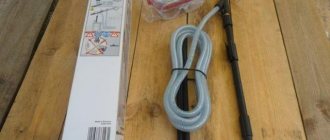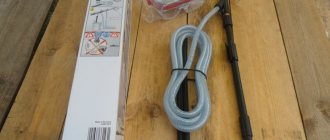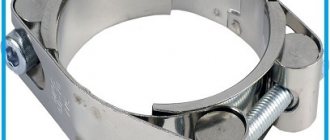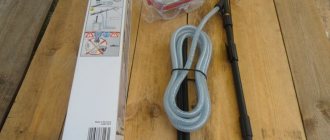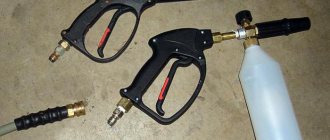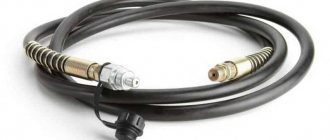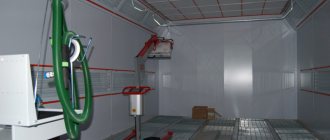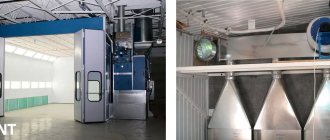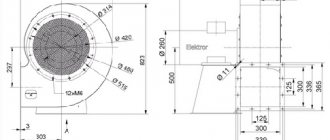Tips for builders | 06/23/2017
The famous brand Alfred Kärcher GmbH & Co. KG, which specializes in the production of high-pressure cleaning equipment, has been promoting sandblasting attachments for its equipment in the specialized market segment for a long time. They are intended for cleaning rust from metal surfaces using a jet of water, which is applied to the product mixed with sand. So what possibilities does the sandblasting nozzle for karcher give us?
Manufacturing method from a spray gun
Sandblasting can also be done using a spray gun. For assembly you need to prepare:
- a gun that functions as a mixing valve;
- handle with air supply device;
- a plastic bottle that acts as a tank for abrasive;
- tee;
- ball valve for regulating sand supply.
Using an airbrush instead of a spray gun will allow you to apply abrasive at higher pressure due to the smaller thickness of the outlet channel.
Assembly is performed in the following sequence:
- The gun is bored to increase the diameter of the output nozzle.
- The mixing tee is attached to the gun.
- The supply and circulation hoses are installed and attached.
Sandblasting from Karcher: nozzle for Karcher high pressure washer
A DIY sandblasting attachment used for installation on a standard Karcher machine will allow you to turn such equipment into a full-fledged sandblasting unit, useful in many situations.
Most Karcher washing machines operate under high pressure, so their technical capabilities are quite sufficient to supply sand through such a nozzle.
The difference between such a homemade device and a classic sandblaster will be that sand will be supplied through its nozzle along with water, but this is not critical for many situations.
Kärcher wet sandblasting kit
How does a sandblasting nozzle work?
The operating principle of any sandblasting installation is that abrasive material from a special hopper enters the nozzle under the influence of an air flow supplied under high pressure.
In serial installations, a separate compressor is used to create such pressure, due to which a significant amount of kinetic energy is imparted to the sand stream emerging from the nozzle. In the case of a Karcher washing machine, the pneumatic equipment built into it will be used for these purposes.
As a nozzle for such equipment, you can use a serial gun, specially designed for equipping pneumatic treatment plants, but in order not to spend money on such a device, you can easily make it yourself.
In order for your homemade sandblasting nozzle, which you will use for installation on a Karcher device, to be effective and not malfunction, you must use high-quality materials for its manufacture.
Of course, the equipment assembled in this way can, at a stretch, be considered as a full-fledged sandblaster, but it is quite suitable for cleaning various surfaces with a stream of water mixed with sand.
When using such a sandblasting device, it is very important to adhere to two recommendations:
- It is better to use distilled water as the working fluid, which will avoid corrosion of the metal elements of the nozzle;
- the sand that will be used as an abrasive must be of a very fine fraction and carefully sifted.
Diagram of a sandblasting nozzle (click to enlarge)
A self-assembled sandblasting machine, the basic elements of which are a Karcher mini-washer and a homemade nozzle, will work according to the following scheme.
- When you press the start button on the nozzle gun, water under high pressure created by the compressor flows past the opening of the intake hose, the other end of which is placed in a hopper with sand. This creates a vacuum in the intake hose.
- Under the influence of vacuum, sand is sucked from the hopper into the main hose, where it is mixed with the water flow.
In order to minimize sand consumption and bring this parameter to a value of 30 kg of abrasive for processing a surface area with a diameter of 70–80 cm, the design of this equipment must be supplemented with taps and dispensers.
Homemade mixer from water taps and tees
What can you use a homemade sandblasting machine for?
The effectiveness of using a sandblasting unit with a homemade nozzle, assembled on the basis of a Karcher apparatus, is ensured by the fact that sand mixed with water is supplied from a nozzle under high pressure, which is created by the built-in compressor of the device. Possessing significant kinetic energy, such an abrasive jet is capable of effectively cleaning various surfaces.
It takes no more than 5 minutes to clean a propane tank from rust and paint.
A homemade sandblaster, assembled on the basis of a Karcher sink, can be successfully used to solve the following problems:
- cleaning surfaces from various types of contaminants;
- removing old coatings from surfaces: paint, glue, building mixtures, etc.;
- removing areas susceptible to corrosion from metal surfaces;
- cleaning metal surfaces before further processing.
Despite the simplicity of its design, a homemade nozzle for Karcher devices, designed for sandblasting, is highly effective in cleaning various surfaces.
The fact that such a nozzle is a convenient and effective device is well demonstrated by the video of its use. Such a video, as well as videos on the manufacture and assembly of such a device, can be found on the Internet without any problems.
Making a homemade nozzle
In order to turn a Karcher mini washer into an effective sandblasting unit using a homemade nozzle, you will need the following structural elements:
- a nozzle through which a mixture of water and sand will be supplied to the treatment zone;
- trigger;
- reinforced hose that will be able to withstand high pressure;
- dispenser necessary to make the consumption of abrasive material more economical.
Nozzle diagram: 1 – thread; 2 – low pressure chamber; 3 – nozzle; 4 – fitting for sand supply; 5 – junction of two parts of the nozzle; 6 – smooth tapering transition
For the nozzle, if you intend to use your sandblaster regularly, it is best to purchase one that is made of ceramic. This type of attachment, which is constantly exposed to abrasive material, will last you much longer than its metal counterpart.
Homemade water sand blasting nozzle
Nozzle details: 1 – pistol; 2 – nozzle; 3 – nozzle holder; 4 – sandblasting nozzle
The efficiency of the sandblasting machine with a homemade nozzle, which you will equip your Karcher sink with, is greatly influenced by the quality of the nozzle. It’s worth starting to create such an element yourself only if you have the opportunity to drill an exact hole in a metal rod, the diameter of which is at least 15 mm. But if this is not possible, then it is better to purchase a factory nozzle, the quality of which will determine the operation of the entire device. The advisability of purchasing a serial nozzle also lies in the fact that some models of such products are already immediately equipped with triggers.
When choosing a hose, the length of which must be at least 2 meters, you should pay attention only to reinforced products. This is explained not only by the fact that such a hose will work under high pressure created by the compressor, but also by the fact that its internal walls will be constantly exposed to abrasive, which will quickly render the unreinforced product unusable.
When starting to assemble and attach the nozzle to equip the Karcher washing machine, you should adhere to the following algorithm of actions:
- a ceramic or metal tip must be fixed to the nozzle of your homemade nozzle using a threaded connection;
- the dispenser, with which you will regulate the flow of the water-sand mixture coming under high pressure from the nozzle, should be attached to the metal or ceramic tip of the nozzle;
- the hose through which sand will be supplied from the hopper must be secured to the back of the nozzle, for which a fitting and a clamp of the appropriate diameter are used.
Scheme of operation and example of manufacturing a nozzle for collecting sand
When assembling and installing a nozzle for Karcher, you should take into account the fact that all elements of such a device will operate under high pressure created by the compressor of the device. That is why all formed connections must be ensured with maximum tightness and reliability. It is not difficult to fulfill this requirement if you make such connections using a special fum tape.
There is one more trick that will allow you to save abrasive material. It consists of the following: cleaning must be performed over a special container with a grid into which the waste mixture of water and sand will be collected. This mixture can be reused by lowering the end of a reinforced hose into it, which is connected to the nozzle of the device. There must be a grate on the top of this container; it is necessary in order to hold processing waste and prevent it from getting into the water-sand mixture.
Karcher sink with sandblasting nozzle in use
Peculiarities
Hydrosandblasting, also known as water sandblasting, also known as hydrosandblasting machine, is one of the types of devices for supplying an abrasive jet when cleaning various surfaces. The specificity of such equipment is that here the jet is formed due to the supply of water.
Therefore, we can say that sanitary and epidemiological standards prohibiting working with quartz sand without eliminating dust are fully observed. In addition, surfaces treated in this way warp less and are better cleaned.
For cleaning, a combination of quartz sand and water is mainly used. Other abrasive materials are in much less demand. An important condition for normal operation of the system is the unhindered pushing of the mixture with water under pressure through the nozzle.
Another advantage of pre-mixing the abrasive with water in the chamber is the ease of handling large parts and hard-to-reach areas. Sometimes it is possible to reduce abrasive consumption by 30-40% when compared with traditional dry processing methods.
In addition, cleaning surfaces with a water jet is a fairly gentle procedure on the material of the parts. Heating of the treated areas is guaranteed to be excluded, so they are not deformed and their appearance does not change.
Also worth noting:
- almost zero risk to the operator’s health (due to the absence of dust);
- obtaining a slightly rough coating (surface adhesion improves, which is good, for example, for subsequent painting);
- effective work with brick and natural stone;
- adjustment of work intensity;
- the ability to wash caustic soda and other detergents;
- guaranteed removal of dirt, rust, scale.
Small particles of sand knock out the dirt. The surface takes on a matte appearance. It is much better to apply primer, varnish or paint to such a base. Additional polishing is greatly simplified. It is hydrosandblasting that makes it possible to obtain samples for studying the macrostructure of alloys. In the industrial sector, many parts cleaned in this way can be ground without lengthy pre-etching.
However, there are also disadvantages:
- it is impossible to work with hygroscopic materials;
- water will splash;
- puddles will appear on the floor.
There are also the following disadvantages:
- the adhesion of wet grains of sand makes it difficult to assess the degree of cleaning;
- the appearance of rust (can be prevented by introducing orthophosphoric acid and some other additives, but this requires additional costs);
- the penetration of water into microscopic cracks allows it to remain under the paint layer and activate oxidation;
- low productivity (dry sandblasting allows you to do much more work per unit of time).
Sandblasting gun with recovery or how to do dust-free processing
Tool manufacturers are constantly improving their creations, which is exactly what happened with compressor attachments - sandblasting guns. The modernization of these devices is that they are additionally equipped with special dust collectors. Such nozzles are called sandblasting guns with abrasive recirculation. These devices with an abrasive recycling system allow sandblasting to be carried out without waste and with minimal sand loss.
Unlike conventional sandblasting nozzles, guns with abrasive recirculation are equipped with a nozzle made of rubber material. Such nozzles not only ensure a long service life, but also allow dust-free processing. The operating principle of a dust-free sandblasting gun with recirculation is as follows:
- The sand released from the nozzle with air hits the surface to be treated, cleaning it
- After this, the sand is not sprayed, but returns to the nozzle, but accumulates in a special bag
- Once the bag is filled with sand, it can be reused
Loss of abrasive material does not exceed 5%, which is very convenient and economical. Closed cycle sandblasting nozzles are also produced based on the recuperation gun. A certain portion of sand is transported in a circle, performing useful work in the form of cleaning the surface. To use the nozzle for a sandblasting compressor with recovery, you should perform the following manipulations:
- Place a nozzle of the appropriate shape on the gun - square, triangular, round, etc. It all depends on the shape of the area being treated
- Bring the gun directly to the area to be sandblasted and apply it closely
- Press the trigger and perform the appropriate manipulations to clean the surface
- The length of time the trigger is held in one place depends on the complexity of the area being treated.
Manufacturers are silent about the fact that pistols with recuperation also have their drawbacks. The main disadvantage is that not only sand accumulates in the bag, but also particles of rust, paint, etc. That is why the sand that accumulates in the bag must be sieved regularly to prevent clogging of the nozzle and channels when reusing abrasives. The video below shows the process of how to work with a sandblasting gun with recovery.
Rules of application
When hydrosandblasting operates, the pump draws liquid from the reservoir. Connecting it to the water supply is prohibited. This inevitably results in a hydraulic shock that destroys the entire water supply system. You also need to ensure that there is a stable flow of pressure-compensating air. In box-type chambers, although small parts are processed, they are processed in fairly large batches.
In this case, operators monitor the progress of work through a control glass. When working using the open method, you can turn on hydrosandblasting only when using special suits, special shoes and safety glasses.
Waterjet treatment is carried out using:
- glass beads;
- regular and quartz sand;
- aluminum oxide;
- soft blasting.
It is strictly forbidden to direct the water jet at yourself and other workers, as well as at foreign objects other than the workpiece being processed. The composition of the working fluid is selected according to the problem being solved. To reduce the corrosiveness of water, sulfonic compounds are used. The optimal amount of abrasive suspension in the liquid is selected experimentally, but in most cases it ranges from 20 to 30%.
It is necessary to carefully select the processing mode. By varying the proportions of the components in the suspension, it is possible to carry out rough cleaning, fine grinding, and preparation for painting.
Before starting work, you must carefully check the serviceability of all equipment, the tightness of the hoses and the accuracy of their connections. The first thing to do is start up at idle speed to make sure the equipment is working properly. Only the next step can be the full processing of the parts or surfaces themselves.
Application areas of the nozzle
Due to the high power of the jet, using the Karcher nozzle you can process various surfaces:
- clean wood and concrete from plaster, old paint, varnishes, building mixtures;
- remove rust and scale from metal;
- clean various products before processing, applying protective and finishing coatings;
- get rid of stubborn stains;
- remove stains and drips of glue and polyurethane foam.
Assembling a sandblaster from a gas cylinder
The simplest design for self-assembly is a homemade pressure-type sandblaster from a gas cylinder. The following elements will be required:
- ball valves – 2 pcs.;
- gas cylinder;
- a piece of pipe from which a funnel is made for filling the chamber with sand;
- tees – 2 pcs.;
- hoses with a passage of 14 and 10 mm, respectively, used to transfer air from the compressor and remove the mixture;
- clamps for attaching sleeves;
- fum tape intended for sealing threaded connections of apparatus parts.
In order to assemble the sandblaster, you must perform the steps in the following order:
- Preparing the tank. Remove all contents from the container, clean the inside surface using non-abrasive detergents and wait until it dries.
- Making holes in the cylinder. The top one will be used to fill in sand - its size should correspond to the diameter of the selected pipe. The bottom hole is for connecting a tap.
- Crane installation. The regulator can be tightly welded or screwed through an adapter pipe.
- A tee and a mixing block are installed behind the tap. Fum tape is used to seal the threaded connection.
- A tap is mounted on the cylinder valve, behind which a tee is installed.
At the final stage, you should take care of the mobility of the device - weld wheels or handles for moving. To increase resistance to do-it-yourself sandblasting, supports from corners, pieces of reinforcement, and tubes are welded.
Then the elements are connected to create channels for supplying and discharging the mixture:
- fittings are placed on the tee located below and the balloon valve;
- a sleeve with a 14 mm passage for air flow is placed between the mixing block and the tee;
- an injection unit is connected to the unoccupied branch of the tee with a fitting;
- a hose for the finished mixture is connected to the remaining outlet of the lower tee.
To ensure tightness, a screw cap should be installed on the pipe for filling the cylinder with sand.
Types of sandblasting guns for compressor
Today you can buy a nozzle for a sandblasting compressor quite inexpensively, which is due to the low quality of such a tool. However, for periodic use of such attachments in the household, they are quite sufficient. Professionals prefer to work with expensive sandblasting guns, which not only have high performance, but are also reliable.
Sandblasting equipment is divided into two types according to the principle of operation:
- Pressure type - abrasive material is supplied from the reservoir through a hose to the nozzle of the gun, and flies out through the nozzle onto the surface to be treated. The principle of operation of the pressure system is based on the fact that compressed air is supplied into a sealed container with sand, which pushes the fine mixture through a special channel into the chamber. The finely dispersed consistency supplied under constant pressure is picked up by a stream of compressed air and transported to the nozzle, from where it flies to the surface. These types of equipment are classified as professional, and they are often used for processing ships, bridges, etc.
- Ejector type (not to be confused with injection ones) - the operating principle is based on creating a pressure difference, from which the effect of suction of a finely dispersed consistency occurs. Sand and air are mixed in a special gun chamber and released through a nozzle
The operating principle of both devices is shown schematically in the photo above. The most popular are ejector-type devices, which are used not only by specialists in car services, but also by home craftsmen.
It is important to note that sandblasting guns differ in the type of location of the container with the abrasive substance.
- With a tank - the container is a component of the gun, which makes the tool similar to a spray gun. Nozzles with a tank have one significant drawback - the need to frequently interrupt to fill the container with sand. That is why such devices are used exclusively for processing small-sized surfaces. These attachments are also used for engraving on glass and other structures.
- With a hose - used when processing large surfaces. The material is supplied from a separate container, which can have different sizes, which is a great advantage, allowing work to continue until the sand is completely used up. Sand is supplied from the container to the gun using a special connecting hose. The nozzle without a tank for connecting the hose is similar to a conventional blow gun
Before choosing a sandblasting gun, you need to decide what size surfaces you plan to process. Often, tools with built-in capacity are enough for home use.
Nozzle manufacturing process
A homemade nozzle for Karcher can turn a washing unit into a functional sandblasting unit for home use. You will need the following set of consumables:
- a hose that can withstand high water pressure;
- trigger hook;
- dispenser to save abrasive consumption;
- a nozzle into which a mixture of water and sand will come out.
Do not experiment with making a homemade nozzle if you are not a professional in this matter. It is necessary to accurately drill a hole with the required diameter. The market is saturated with ready-made parts and consumables of decent quality at reasonable prices, so it’s better to purchase them. In addition, the finished parts already have a trigger mechanism in the kit - a hook.
The hose you will use must be at least two meters long, durable and reinforced. A stream of water with high pressure will pass through it, which will be created by the compressor. Strength is also important because the unit will work with abrasives, so a product of dubious quality will not last long.
Algorithm of actions
- Using a thread, the tip is fixed to the nozzle.
- A dispenser is also attached to the nozzle, which regulates the supply of sand-water mixture.
- The container with sand is connected via a hose; for this, a suitable clamp and fitting are used.
To save the most sand, you should prepare a special container with a grate. Above it, you need to carry out the necessary cleaning of the surface using a sandblasting nozzle. The water-sand mixture will accumulate in this container. This mixture can be used again if a reinforced intake hose is lowered into it. The grate covering the container is needed to keep waste from being cleaned so that it does not contaminate the sand and water mixture.
How does a sandblasting nozzle work?
Karcher with a sandblasting nozzle consists of the following components:
- AWD Preus mini-compressor, which is included when the consumer purchases basic cleaning equipment from the Kärcher brand.
- A serial gun that controls the flow.
- Adapter attachment designed for use with water-sand mixture.
- A hose whose manufacturing technology takes into account the significant abrasive effect of the flow on the walls.
- Containers with sand.
- Receiving nozzle for sand selection.
When all of the above elements are connected to each other, the receiving nozzle is immersed almost to the bottom of the container with abrasive, after which the high-pressure water supply is turned on. By adjusting the flow rate using an adapter, you can control the diameter of the water-sand mixture and the intensity of its impact on the surface being cleaned. The duration of sandblasting is determined by the amount of sand in the container.
The characteristics of the sandblasting nozzle for kärcher declared by the manufacturer are:
- The maximum developed pressure is up to 140 at;
- The recommended distance from the adapter to the surface to be treated is no more than 300 mm;
- Hose length – 3 m;
- The nominal consumption of abrasive for processing flat surfaces is 50...60 kg/m2;
It should be noted that, for the compactness of the installation, it does not include dispensers and control valves, and sand is sucked in exclusively due to the vacuum created in the main water line. Judging by user reviews, this is a significant design flaw in the device.
However, the features of the practical use of the hydrosandblasting nozzle for Karcher are not only this.
Sand for hydrosandblasting
It’s worth starting with the choice of consumables, since the principle of sandblasting itself is trivial. Unless the flow of sand is supplied directly from the compressor unit, but is captured from the tank by a flow of water, which has a sufficiently high kinetic energy for these purposes. This is precisely the subtlety of using sandblasting nozzles for Karcher
The instructions for use recommend that the user only use sand supplied by the nozzle manufacturer. And this is no coincidence. Those who did not pay attention to this detail then pay with a sharp decrease in the speed of the cleaning mixture, and, accordingly, a decrease in the efficiency of sandblasting. There are plenty of reviews on the problem that has arisen.
Sand used in sandblasting nozzles has a number of features:
- Extremely uniform in fraction - 0.3...0.5 mm, no more and no less (a finer fraction will only produce grinding; the disadvantages of larger fractions will be discussed later).
- The particles have a rounded shape in plan, without sharp protrusions and corners.
- The sand must be strong enough so that it does not crush and disintegrate into smaller fractions after the first use.
- The supplied material must be completely dry before mixing with water.
Sandblasting with a high-pressure washer can be used to clean relatively small surfaces of a simple, flat shape (the sand consumption coefficient when working with more complex configurations will be several times higher). The sand itself cannot be recycled or recycled after processing. This is explained not only by the difficulty of collection, but also by the need for particularly thorough cleaning, since waste sand contains particles of materials torn off from the cleaned surface.
The technology for preparing “branded” sand from kärcher is characterized by a high degree of purification of the starting material – river or quarry sand. After grinding in high-precision ball mills, the semi-finished product is additionally calcined. This increases mechanical strength and makes it possible to use the abrasive for sandblasting not only relatively soft non-ferrous metals and alloys, but also steels. During the preparation of sand, larger fractions with a diameter of more than 0.6 mm enter the container: the grains of sand become noticeably heavier, and the kinetic energy of the water flow is insufficient to capture them and deliver them at the required speed (at least 350 km/h) onto the surface to be cleaned.
Choosing sand for a sandblasting gun
An important question when treating surfaces with sandblasting guns is which sand to choose. Many inexperienced craftsmen use ordinary street sand for such purposes, which ultimately leads to rapid failure of the equipment. In addition to the fact that street sand contributes to the disabling of the nozzle, it can also damage the surfaces being treated. When choosing consumables for sandblasting guns, it is important to consider the following factors:
- Fraction size - depends on criteria such as nozzle diameter, compressor pressure and the desired result
- Material hardness - a 10-point scale is used for evaluation. It is not always necessary to choose sand of high hardness, as it depends on the type of material of the surface being treated
- Abrasive ability - this parameter characterizes the time during which the consumable material will cope with the task. The higher the abrasive ability, the greater the amount of work that can be completed in a short period of time.
- Recovery ability - this parameter is important to consider when using a special tool with a sand collector
Four types of sand are used for sandblasting:
- Quartz - characterized by low cost and availability. The material is characterized by a large amount in its composition, which has a positive effect on the quality of processing. The disadvantage of quartz sand for sandblasting is that it is harmful to health, so work must be carried out strictly using protective equipment, and there should be no people or animals nearby.
- Corundum is a material that is excellent for working with high-strength coating materials. Corundum sand is capable of recovery, and it is used in a variety of fields
- Garnet is an abrasive material that is environmentally friendly, but it is used on equipment that operates on high-pressure water.
- Cooper slag has a high density of abrasive substances, and at the same time it can be used for re-processing. The composition contains quartz particles that are harmful to human health, so it is important to wear protective clothing when working.
When choosing sand, you also need to consider what type of sandblasting equipment is used. These can be closed or open type devices.
This is interesting!
Only dry sand should be used for sandblasting.
Main components of sandblasting machine
Homemade sandblasting is assembled on the basis of standard schemes, differing in the method of supplying sand to the contaminated part. Despite the existing design differences, the components for both options are the same:
- compressor - a device for pumping air mass;
- a receiver necessary to create the necessary air supply;
- abrasive tank;
- gun - the main device designed to supply an abrasive mixture to the surface to be cleaned;
- hoses.
Sandblasting machine device
The device, regardless of the assembly scheme, forms a combined output flow of air and abrasive. When assembled according to a pressure circuit, sand under the influence of pressure enters the outlet pipe, in which it is mixed with the air supplied from the compressor. To form a vacuum in the abrasive supply channel in ejector devices, the Bernoulli effect is used. Sand is fed into the mixing zone under the influence of only atmospheric pressure.
The existence of many options for sandblasting manufacturing schemes is explained by the possibility of creating it from materials at hand, which often seem unnecessary. To understand the essence of the process, it is enough to consider the general principles of assembly.
How does a sandblasting gun work?
If you decide to use a sandblasting gun for the first time, it will not hurt to first understand the question of its operating principle. Knowing the principle of operation of the nozzle, it will not be difficult to learn how to use it. First, let's find out how a sandblasting gun from a compressor works:
- The gun is connected via a hose to the compressor through the receiving fitting
- The air enters a special chamber where its pressure can be adjusted
- The air is directed through the channel to the nozzle
- Due to the passage of air through the channel, sand and abrasive are sucked from a special container (due to the pressure difference)
- The amount of sand sucked in by air can also be adjusted with a special screw, which depends on the tool manufacturer
- Not only compressed air is supplied through the nozzle, but also sand with abrasive particles, which have a cleansing effect on the surface
The operating principle of the tool is somewhat similar to the functioning of a spray gun. Often these two tools are used simultaneously when performing paintwork. Initially, the surface is cleaned and then painted. Moreover, this applies not only to car bodies, but also to various structures on the farm, for example, gates, fences, poles and others.
Nissan Patrol QD32 › Logbook › Sandblasting from Karcher and eliminating bugs
The patrol is a good car. But it is highly susceptible to corrosion. I wanted to treat the hidden cavities with a liquid rast-stop, and from the bottom outside with a thick one. Rust-stop is a good thing, but if it somehow stays in cracks and hidden cavities, then in open, level places it is quickly washed away, especially by reagents and petroleum products that somehow get on the asphalt (everyone has noticed that on the highway, “windshield wipers” smear on an oily film on the glass?). Therefore, I couldn’t smear it, I had to eliminate the bugs at least in open areas and paint it. This is what the frame and side members looked like before work began:
These are the worst places. At the same time, I feel the frame and side members inside with my finger through the technological holes - everything is smooth there, i.e. The paint is still in place. It’s strange, on Padzherik it was the other way around.
I was puzzled as to how to clean off the rust. It’s not realistic to use your hands; you can’t get anywhere with a drill or an angle grinder with a carriage brush. The ideal option is sandblasting. But I need a powerful compressor, which I don’t have. And then on the internet I came across a sandblasting attachment for a Karcher. This is what she looks like:
I immediately ordered it on ozone and the next day I held it in my hands. Of course, the money they ask for it (4200 rubles) is probably not worth it as a product (like all Karcher products have an inflated price tag). But looking ahead, I will say that I have never regretted the purchase, because... it saved me a lot of time and effort. All that remained was to find sand. There are no instructions for the attachment, only pictures on the box. The picture shows a bucket of abrasive and its number according to the original catalog. Having punched the number, I found out that the original abrasive comes with a fraction of 0.2-0.8mm. I started looking for fractional sand.
In our village this is a hopeless occupation. But a friend helped me by fitting an open bag from his work. This bag was enough... um... well, just to start. The 15-20 kg that remained in it ended instantly. The consumption of sand turned out to be simply enormous. I started scouring the internet for ordering fractional sand. I found some website (for some reason it can’t be Googled now), placed an order for the minimum quantity (500 kg), but the manager never contacted me. I went to Leroy Merlin and bought regular construction sand “Bolars” in 25 kg bags. I took 6 bags. The website says that the fraction is 1-2mm. In fact, it was different in each bag, from small to large. So 1-2mm is probably the maximum size of sand grains. Unlike the fractional one, it contains dust, which clogs the nozzle. But you can work if you get used to it.
Started to get sandy. I removed the pegs for better access. At first I worked as a Karcher K5 (borrowed from my brother). Then I finished it with K3. The latter takes a little longer to clean, but the difference is small. The advantage of water sandblasting is that there is no dust. The downside is that the cleaned metal surface is quickly covered with a thin layer of rye. In progress:
Where the rust is ingrained and has grooves, it is better to use fine sand, because... large ones take a long time to get it out of the cracks. It is better to clean off scale with coarse sand. All this action requires good equipment. The glasses that come with the attachment are UG. Uncomfortable and do not fit well, sand flies into the cracks. In general, after the sandblasting procedure, the underbody washing I experienced earlier seemed like a children's party.
It's time for painting. After drying, a coating of rye appeared on the metal.
It can be easily removed by any rust converter. But here is a pipe and a jug. After the reaction, the converter must either be cleaned or washed off with water. It’s not possible to clean it off everywhere, but when you wash it off with water, you get back a coating of rye. I tried to wash it off with gasoline, but it didn’t wash off. Therefore, after washing it is necessary to quickly dry, degrease, prime and paint.
After painting, I covered the sills with anti-gravel BODY 950 and put a couple more layers of paint on top (since the body is porous, it is better to paint it on top). Later I’ll go through everything with a rust-stop. In the next part I’ll tell you about the rear arches
Sandblasting nozzle for a Karcher: do-it-yourself sandblasting from a sink
To quickly and efficiently clean surfaces from dirt, old paint and rust, it is best to use sandblasting.
This type of cleaning is carried out using special equipment - cameras, guns.
If you have a high-pressure washer, you can save on the purchase: the sandblasting nozzle on the Karcher will help in everyday life and repairs, and you can make it yourself.
Operating principle of the nozzle
Whatever the sandblasting machine, the principle of its operation is as follows: as a result of the operation of the compressor, the air flow is under high pressure, due to which abrasive (usually sand) enters the nozzle of the device. The latter is fed through the outlet hole in a thin but strong stream directly onto the object being processed, as a result of which the top layer is removed.
Sandblasting for Karcher is a device that can make a high-pressure washer suitable for work like a sandblasting gun.
This attachment will not replace professional equipment, but it is perfect for cleaning small surfaces.
Instead of air, the charge of kinetic energy will be given to each portion of sand by water, but otherwise the principle of operation of the device will remain the same:
- under the influence of the high pressure created by the compressor, water passes through the intake hole of the hose, the other end of which is placed in a container with sand;
- a vacuum is created in the intake hose, which helps the abrasive move into the main hose;
- After mixing sand and water, the flow is supplied through the outlet to the surface of the product.
To reduce sand consumption and increase processing efficiency, dispensers and taps can be introduced into the specified design. Typically, a sandblasting nozzle for Karcher consumes 30 kg of sand for every 0.8-1 square meter of surface.
Application areas of the nozzle
Due to the high power of the jet, using the Karcher nozzle you can process various surfaces:
- clean wood and concrete from plaster, old paint, varnishes, building mixtures;
- remove rust and scale from metal;
- clean various products before processing, applying protective and finishing coatings;
- get rid of stubborn stains;
- remove stains and drips of glue and polyurethane foam.
Making a homemade nozzle
A special nozzle for a high-pressure washer turns the latter into a good sandblasting unit; it is only important to purchase high-quality components. You will need:
- reliable hose with the ability to work under pressure;
- dispenser to save abrasive;
- nozzle for throwing sand and water;
- trigger hook;
- clamp and fitting.
The quality of the nozzle will determine the durability of the nozzle and the final result, so it is better not to skimp on it. Ceramic devices fail faster than those made from tungsten and cobalt alloys.
However, metal nozzles can be susceptible to rust due to the presence of water in the sink, so sooner or later any nozzle can deteriorate.
For more expensive devices, the trigger is included, otherwise you will have to buy it separately.
The nozzle on a Karcher for sandblasting must include a reinforced hose at least two meters long. You should not purchase hoses without additional reinforcement of the frame - they are not capable of operating under pressure of several atmospheres. A product of dubious quality will tear quite quickly.
Recommendations for safe use of the nozzle
In order not to harm yourself, it is necessary to work with the high-pressure washer and the nozzle in compliance with safety precautions, otherwise the water-sand mixture can cause injury. The advantage of such a device over a conventional sandblasting gun is the absence of dust settling in the lungs, so there is no need for a respirator. But you need to follow these tips:
- wear durable protective clothing;
- wear comfortable closed shoes;
- Clean products outdoors rather than indoors.
If you have a Karcher sink or its equivalent, it is not difficult to build a sandblasting unit yourself. This will save money and allow for high-quality surface treatment for every need that arises.
Recommendations for safe use of the nozzle
When using a homemade nozzle on a Karcher machine for sandblasting, you should adhere to safety requirements when working with such equipment. When using a Karcher washing machine, only water is supplied from its nozzle, which is not capable of harming the health of the operator. When using a sandblasting nozzle, in addition to high-pressure water, sand is also supplied from the tip of such a device, which can seriously injure the person operating such equipment. That is why when using such an attachment it is important to strictly adhere to the following safety rules:
- Processing should only be carried out in special closed-type clothing;
- shoes used for treatment using such a device must also be closed;
- All sandblasting work is best done outdoors.
Protective equipment when working with a sandblasting machine
Considering the fact that when using a Karcher apparatus and a homemade sandblasting nozzle, processing is carried out using a mixture of sand and water, it is not at all necessary to use face and respiratory protection in such cases.
When starting to make a sandblasting nozzle with your own hands, you should keep in mind that it will work effectively only if the compressor of your Karcher mini washer is capable of producing a stream of water under a sufficiently high pressure.
More on the topic: > Do-it-yourself sandblasting: drawings, videos, manufacturing instructions > Homemade sandblasting gun > Do-it-yourself sandblasting chamber: drawings, components, assembly
What else can a nozzle and gun be made from?
Making your own sandblasting gun is not difficult. For assembly, you can use a nozzle for a regular ball valve located at the end of the hose for discharging the air-sand mixture. The nozzle is a nut that clamps the outlet nozzle for the abrasive.
The nozzle, in turn, can be made on a lathe. But it is more rational to use a spark plug. The worn-out part is cut with a grinder, while the durable ceramic rod is separated from the metal parts of the structure, and its length is adjusted.
DIY designs are often more effective than pistols, a wide range of which are commercially available. Therefore, if you have free time, it is wise to spend it on implementing your technical solution, and spend the saved money on other, no less important goals.
Making sandblasting yourself allows you to reduce the cost of purchasing a serially assembled machine by 3–5 times. Maximum savings can be achieved by using a homemade compressor, but it is very difficult to achieve sufficient power. The best option is do-it-yourself sandblasting in combination with a powerful factory compressor.
Searching for records using a filter:
